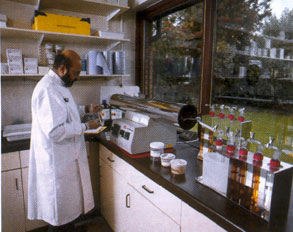| 2003 |

|
YEAR BOOK |
The Radiological Protection Institute of Ireland
|
Radioactivity monitoring for foodstuffs
|

The safety of food and food products is a major concern of the Irish public. The Radiological Protection Institute of Ireland (RPII), as the designated national centre for the measurement of radioactivity in foodstuffs, monitors the environment, environmental samples and food products to ensure that the public are not exposed to unacceptable levels of radiation.
The RPII carries out two distinct but complementary monitoring programmes - one concentrating on the marine environment and the other on the terrestrial environment. The principal objective of these programmes is to assess the level of exposure of the Irish population, primarily through the consumption of foodstuffs, to radioactive contamination. The results of these programmes are published on the RPII website (www.rpii.ie) as the 'Marine Monitoring' and the 'Environmental Surveillance' monitoring reports.
The foodstuffs monitored by the RPII include fish, shellfish, milk, drinking water, dairy produce, meat, vegetables and grain.
In terms of the marine environment, discharged radioactive waste from the British Nuclear Fuels plc (BNFL) reprocessing plant at Sellafield continues to be the dominant source of artificial radioactivity. The consumption of fish and shellfish is the main way the Irish public are exposed to radiation as a result of these discharges. The dose to consumers who eat substantial quantities of seafood (20 g shellfish, 200 g of fish per day) was estimated for 2002 to be less than 2 microsieverts (�Sv). This dose may be compared with that attributable to the presence in seafood of the naturally occurring radionuclide, polonium-210, which is estimated to be 148 �Sv annually for the same consumers. It may also be compared with the average annual dose of 3620 �Sv to a member of the public from all sources of radiation.
Measurements carried out on drinking water and other foodstuffs show that the levels of artificial radioactivity remain low and are well within accepted international limits, and consequently do not pose a significant risk to health.
Contact: Mary Fegan; E-mail: [email protected]